UV溶融石英(UVFS)すりガラス拡散板
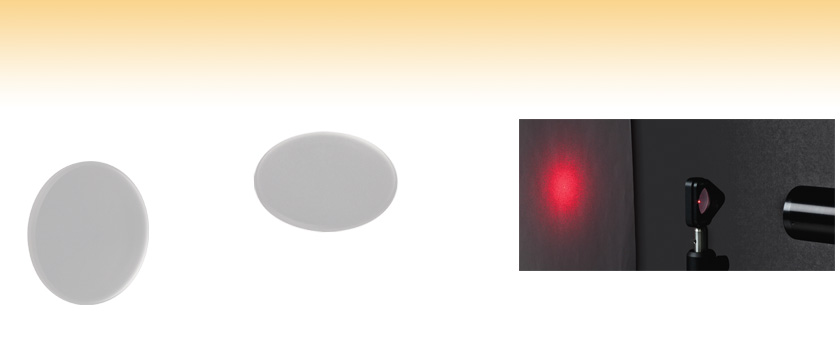
- Superior Transmission in UV Range
- Offered in 120, 220, 600, and 1500 Grit Polishes
- Polished for Greater Uniformity than Sand Blasting
DGUV10-120
DGUV10-220
Application Idea
DGUV10-600 Mounted in KB1P Quick-Release Mount

Please Wait
特長
- Ø25.4mm(Ø1インチ)円形拡散板
- UV溶融石英基板
- 225 nm以上の波長で90%以上の透過率
- ガウシアン強度プロファイル
- 開口: 直径の90%以上
UV溶融石英すりガラス拡散板は、入射光の強度分布をガウシアン状の拡散分布に変換します。 N-BK7基板から作られた拡散板とは異なり、UV溶融石英の拡散板は波長350 nm以下の波長で高い透過率を示します。加えて、UV溶融石英では実質的にレーザ誘起蛍光が存在しないので(193 nmで測定)、UV域から近赤外域に及ぶ用途に適しています。 N-BK7およびUV溶融石英の透過率の波長依存性の比較は「比較」タブでご覧いただけます。
すりガラス拡散板は、粒度が120、220、600、1500のいずれかの研磨剤で片面が研磨され、拡散面(すりガラス面)が形成されています。この研磨行程により、サンドブラスト拡散板よりも格段に高い表面均一性を得ることができます。 様々な研磨剤が、細かい散乱から粗い散乱まで幅広い散乱を可能にします。 細かい研磨(1500グリットなど)では透過率が高くなります。粗い研磨(120グリットなど)では透過率が低くなりますが、拡散のパターンは広がります。右の画像をクリックいただくと、それぞれのガラス拡散板の強度プロファイル幅を比較していただけます。また、拡散板の透過率は「グラフ」タブでご覧いただけます。
拡散板を取り付ける時には、拡散面(すりガラス面)を光源と反対側に向ける必要があります。これらの拡散板を固定できるレンズマウントをご提供しています。
UV域の透過率を必要としない用途では、N-BK7すりガラス拡散板をご検討ください。
| Diffuser Selection Guide | |||
|---|---|---|---|
| Ground Glass Diffusers | |||
| Standard Diffusers | N-BK7 Substrate | Unmounted, Uncoated | 350 nm - 2.0 μm |
| Unmounted, AR Coated | 350 nm - 700 nm 650 nm - 1050 nm | ||
| Mounted, Uncoated | 350 nm - 2.0 µm | ||
| UVFS Substrate | Unmounted, Uncoated | 185 nm - 2.0 µm | |
| Diffuse Reflectors | N-BK7 Substrate | Unmounted, UV-Enhanced Aluminum Coated | 250 nm - 450 nm |
| Unmounted, Protected Silver Coated | 450 nm - 20 µm | ||
| Unmounted, Protected Gold Coated | 800 nm - 20 µm | ||
| Alignment Disks | |||
| Engineered Diffusers®* | |||
| Glass Diffusers | UVFS Substrate | Unmounted and Mounted, Uncoated | 193 nm to 2.0 µm |
| Polymer Diffusers | ZEONOR Substrate | Unmounted and Mounted, Uncoated | 380 nm to 1.1 µm |
| Diffuser Kits | |||
*Engineered Diffusers®はVIAVI Solutions社の登録商標です。
| Common Specifications | |
|---|---|
| Diameter | 1.00" |
| Thickness | 2.0 mm |
| Clear Aperture | > 90% Diameter |
| Surface Flatness of Smooth Side (@ 633 nm) | < λ |
| Surface Quality of Smooth Side | 80-50 Scratch-Dig |
| Parallelism | < 3 arcmin |
| Item # | Grit |
|---|---|
| DGUV10-120 | 120 |
| DGUV10-220 | 220 |
| DGUV10-600 | 600 |
| DGUV10-1500 | 1500 |
透過率はデータの取得方法に影響されることにご注意ください。 この測定では、積分球センサと分光器が共に用いられています。分光器では許容受光角度が小さいため、グリット値が小さくなり大きく分散した光を全て受光するのが困難になります。したがって、グリット値が低くなると透過率も低くなります。
双方向散乱分布関数(BSDF)のグラフ
ここに示すデータは、拡散板に向けてHeNeレーザ光を照射し、拡散板の周囲を受光器を回転させて角度分解散乱光(ARS)を測定することで取得しています。双方向散乱分布関数(BSDF)は、ARSを入射ビームと受光器の間の角度の余弦で除することで求められますが、これは光が拡散板を通過した際に発生する散乱の量を表します。これらのグラフのX軸は散乱された角度を示しています。そのため0°でスパイクが現れる場合がありますが、これは拡散されずに透過するビームを表しています。
N-BK7とUV溶融石英の比較
N-BK7の基板は、低価格で、可視光域および近赤外域の一部の波長で優れた透過率を示すため、一般的に用いられます。 しかしながら、350 nmより短波長では透過率が著しく落ちてしまいます。 紫外域での用途では、UV溶融石英が適しています。 UV溶融石英は、深紫外域でも高い透過率と均質性を示し、N-BK7と比べて熱膨張係数は低いです。 加えて、UV溶融石英では実質的にレーザ誘起蛍光が存在しないので(193 nmで測定)、UV域から近赤外域に及ぶ用途に適しています。 N-BK7とUV溶融石英を右のグラフで比較していますので、ご参照ください。
紫外域での透過率を必要としない用途では、N-BK7すりガラス拡散板をご提供しています。
| Posted Comments: | |
Patrick Chang
(posted 2024-01-08 16:56:24.543) Could you please let me know or provide the simulation model for light tracing software like TracePro or LightTools?
(For example, set scattering/scattering model... how to set the parameters that can be equal to 220 Grit) jpolaris
(posted 2024-01-08 06:49:26.0) Thank you for contacting Thorlabs. At the moment, we do not have simulation files, nor do we have BSDF files for these UVFS ground glass diffusers. The BSDF data provided on our website was measured in a transmission based scatter setup, not simulated. However, we do have Zemax and BSDF files for our Engineered Diffusers. I have reached out to you directly to discuss further. If you would like to browse our Engineered Diffusers, the following link will take you to our Engineered Diffuser page. https://www.thorlabs.com/newgrouppage9.cfm?objectgroup_id=1660 an jieun
(posted 2023-04-06 14:05:06.94) Hello. We are interested in your products and will contact us. Currently, the performance of the LED module I want to develop is 255nm band, and the size is about 50x50(mm). This wavelength band has a strong straightness and wants to spread, but do you have a larger diffusion plate?
thank you. cdolbashian
(posted 2023-04-13 10:22:45.0) Thank you for reaching out to us with this custom request! I have contacted you directly regarding performance quality, specs, and quantity. For future custom requests, please feel free to email TechSales@thorlabs.com. Viktor Goldovsky
(posted 2021-08-18 21:11:22.883) hi,
what is the pattern diameter of this DGUV10-120?
thank you cdolbashian
(posted 2021-08-31 02:59:23.0) Thank you for reaching out to us Viktor. The pattern diameter is random and does not necessarily the same as the particle size used to make it. Jordan Rabinowitz
(posted 2020-08-20 10:34:29.96) Hello,
I have questions about the plot on your website for the normalized power vs angle from the diffuser.
What wavelength was this measurement taken with? We have a 1064nm laser and need to know if the power vs angle plot will be significantly different.
If possible, can you also send me the raw data from this plot?
Thank you YLohia
(posted 2020-09-04 10:03:02.0) Hello, thank you for contacting Thorlabs. These measurements were taken at 635 nm. We don't expect to see a significantly deviating performance at 1064 nm. We will reach out directly with the raw data. yuheng jiang
(posted 2020-08-12 20:06:13.54) Excuse me, is there a damage threshold for each diffuser? our laser is @266nm 10Hz. Thank you! nbayconich
(posted 2020-08-13 03:16:12.0) Thank you for contacting Thorlabs. We have not performed official laser damage threshold testing for our UVFS ground glass diffusers, however being that the surfaces are ground and not polished as our windows are, the theoretical damage threshold for UVFS diffusers would be lower than that of a UVFS polished window.
I will reach out to you directly. Cheng Xu
(posted 2020-02-06 19:53:33.753) Hi , could you send me the BSDF data of the above product?
Best,
Cheng nbayconich
(posted 2020-02-11 11:00:23.0) Thank you for contacting Thorlabs. We do not have BSDF data for these diffusers at the moment however we do have a transmission plot vs. output angle plot on our website below.
https://www.thorlabs.com/images/TabImages/DiffuserAngularTransmission_780.gif Hashimadelbanah
(posted 2018-10-15 04:38:15.013) Hi, I would like to know what is the damage threshold for this diffuser?
In other words, what is the maximum power this diffuser can hold out?
One last question, what does Grit means?
Thanks. nbayconich
(posted 2018-10-23 04:32:28.0) Thank you for contacting Thorlabs. We have not done official laser damage threshold testing for our UVFS ground glass diffusers, however being that the surfaces are ground and not polished as our windows are, the theoretical damage threshold for UVFS diffusers would be lower than that of a UVFS polished window.
The grit number refers to the size of the grit used to polish the surface of the UVFS material, lower grit number meaning a coarser or larger grit particle size.
I will reach out to you directly to discuss your application. nimrod.nisism
(posted 2018-09-27 16:51:23.163) I would like to purchase the the DGUV10-1500 but with larger diameter > 2" can you help me ?
BR,
Nimrod Nissim YLohia
(posted 2018-09-27 12:30:29.0) Hello Nimrod, we will reach out to you directly to discuss the feasibility of offering this. Custom items should be requested by contacting techsupport@thorlabs.com. |
 Products Home
Products Home









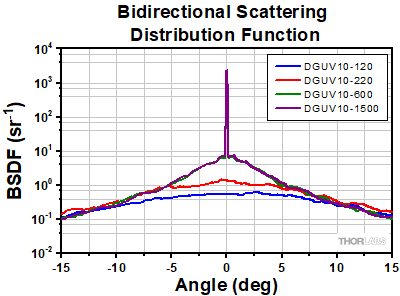
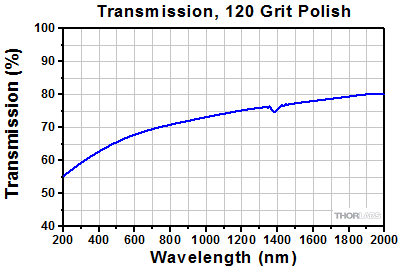
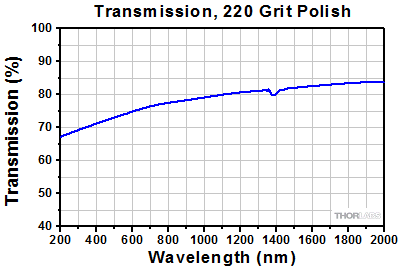
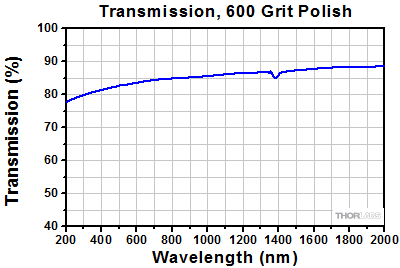
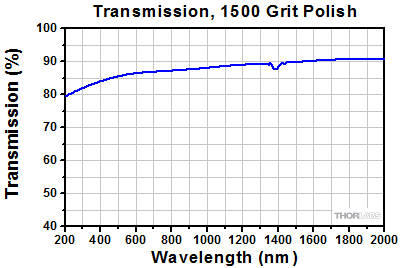



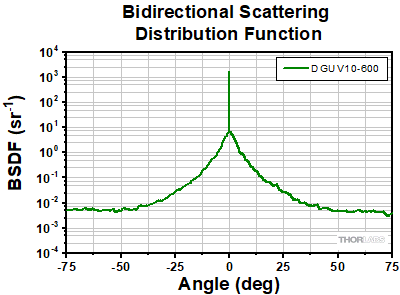
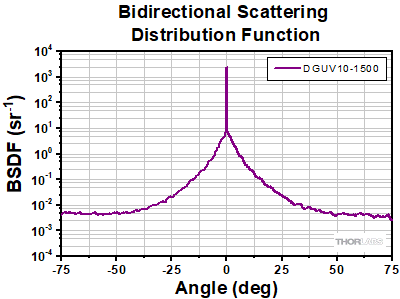
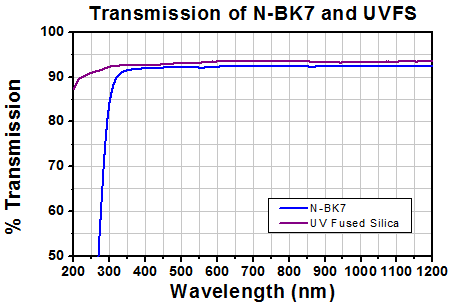
 UV溶融石英(UVFS)すりガラス拡散板
UV溶融石英(UVFS)すりガラス拡散板